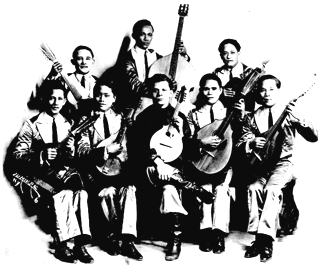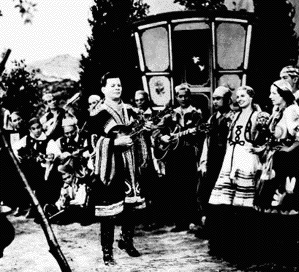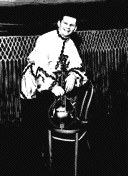Russia to Vaudeville 1897-1940
by David Grisman
(Reproduced from Mandolin World News, Vol. II, No. III, and Vol. V, No. III. Copyright 1977, 1980 Mandolin World. Used by permission. All rights Reserved.)(Special thanks to the Apollon family (Danzi, Mike, and Leo) and Milton Kaiser for their kind assistance in the preparation of this article.)

DAVE APOLLON, WHO CAME TO BE KNOWN as the "world's greatest mandolin virtuoso", was born in Kiev, Russia on February 23, 1897. Although Dave was an extremely talented dancer who ultimately gained world-wide fame as a vaudeville personality, his first love was the mandolin. There are several different versions of how Dave got started playing the mandolin, somewhere between the ages of seven and ten. Each story has Dave studying violin, one with a fat woman who accidentally sits on his instrument, and another with a heavy vodka drinker who, annoyed at Dave's scratchy bowing, loses his temper and destroys the instrument, predicting that Dave will never be a violinist. As it turns out in each version, Dave acquired a mandolin (probably bought by his father) and proceeded to learn to play it without a teacher. A couple of years later, when a world reknowned Italian mandolinist was touring Russia, Dave sought him out and asked for help. This mandolinist showed him how to hold the pick and a number of other "tricks".
By the time he was fourteen, Dave was playing well enough to organize his own orchestra to play in a movie theater in Kiev. Two years later, he gave his first solo concert performance in which he played "Czardas" by Monti, "Chopin Waltz", "Poet and Peasant Overture", and the "Moonshine Variations". The next few years saw the young mandolinist struggling through the rigors of the Russian Revolution, culminating with his arrival in San Francisco in 1919.
He headed for New York city, where he was reunited with a brother who had believed that he had been killed in Russia. This brother offered Dave a position in his leather business, but Dave was bent on a career as a musician. When he told an agent that he was a mandolinist, the man laughed and said, "That barber shop instrument?" Undaunted, however, he gave a Friday morning audition at the Palace theater, was hired and opened the following Monday, filling in between the dancing of the Ford Sisters, a popular act in the early years of vaudeville. He played "Gypsy Airs" by Sarasaste and brought the house down. He was immediately signed to a three year contract with the Keith-Albee circuit, and began a career in vaudeville which would span nearly twenty years.
Oddly enough, it was not his mandolin playing that brought Dave the tremendous popularity and success he was to achieve in vaudeville; it was his Russian accent! Amazingly, it was Mae West who first noticed this unusual asset. In her autobiography, "Goodness Had Nothing To Do With It", Mae narrates her first encounter with Dave when they both were part of the Ginger Box Review at the Greenwhich Village Theater in New York, 1923:
"At a rehearsal of this show I first met Dave Apollon. He had just arrived in this country, after some hardships, and was in the show. He was a fine mandolin player and Russian dancer. I first saw him dressed in a very tight-fitting green tweed suit that looked as if it had been made for a smaller brother, high button shoes, and a high Hoover collar. He was short but slender, with a round elf's, face and a turned-up nose over a mocking mouth. He had a sour-cream heavy Russian accent, and a very amusing way of expressing himself in a fractured English almost like double-talk.
Dave was very funny, I thought, but in the show he just played the mondolin and did a short dance. I couldn't help being amused by him and I would have him come to me so that I could ask him questions just to hear him mangle the language. I would try not to laugh out loud, just inwardly, and somehow everything became funnier that way. When Dave Apollon would start talking it would break me up inside. He'd ask, 'Whut suz funnik I'm saying please to tell me?
I said to him, "Dave, with your mannerisms, voice, and puzzled expression that seems to struggle to understand what is said, you make me scream with laughter. What would you be able to do to an audience?"
"But no thenk you - I serious minded fella, this mandolin and dancing very serious for me is enough."
Mae perservered and soon had Dave reading lines in a skit about the Greek goddess Circe and her lovers. When the show opened in South Norwalk, Conneticut, it was discovered that the scenery was too small for the theater. The producer was about to write a formal apology for the theater manager to read to the opening-night audience, when Mae came up with an idea!
"Get Dave Apollon to go out before the curtain, in a spotlight, in his own tight little green street suit, and with that borscht dialect he should really be, funny telling them about the scenery." They captured Dave, fed him hot tea, patted his back, told him he could do it. He said weakly, "It was better with the Czar and the lousy pogroms."
Dave, finally did go out on the stage to make the announcement, and the more he got tangled up in the English language, the more scared and bewildered he looked, the more the audience howled. He became so screamingly funny the audience doulbled up in the seats. They applauded madly, thinking it was all a part of the original show. He came off popeyed. "I sweating like a hoss," he said.
That was the beginning of a career for Dave Apollon. He was getting forty dollars a week, but the fact that he could make an audience laugh just by talking got him a raise that night. He later became a headliner at the Palace Theater, and even a master of ceremonies. He said years later, "Mae, me getting a few thousand a week instead of just playing the mandolin like the number two act on a bill. Is America - is great!"

Another one of Dave's great attributes, which facilitated his rise to stardom in vaudeville was his ability to spot talent. In 1926 he met a group of Phillipine string players who had just lost their job in another show. He immediately hired them to be his "orchestra" and began working up the routines and musical numbers that would be part of his show (with various other singers, dancers, jugglers, and comedians) until the late 1930's. This group, which numbered from seven to ten players, used bandurias, mandolins, domras, guitars, bass and accordian. They all were talented musicians who knew hundreds of tunes, and together with Dave they evolved a rapport that was both musical and entertaining. "It cost me a lot to bring these boys from Russia. I hope you like them 'cause it's going to cost me more to send them back!"
In 1928, Dave was introduced to Miss Danzi Goodell, a young dancer who had evolved an unusual "eccentric" dance routine, complete with felt hat and spats. After seeing her dance in his dressing room, in between shows, Dave got up from the sofa he was Iying on and said, "You're going on with my show next performance! You're going to be a sensation...but don't get a swelled head!" Danzi joined Dave's review and toured with him for the next seven years. In 1935 she left vaudeville to work in night clubs, but retired from show business in 1937 when she became Mrs. Dave Apollon.
Throughout the late twenties and early thirties, the Dave Apollon Revue was one of the top acts on the Albee circuit. They'd play the Palace in New York for 25 weeks and then tour the rest of the country for more than a year. Dave produced the whole show and was loved by all those who worked with him. He was a perfectionist with great sensitivity and concern for all of his "family". Unfortunately, Dave's new found theatrical success shifted the emphasis of his career away from mandolin playing in terms of recordings and legitimate concertizing.
Nevertheless, in 1929 Dave Apollon made his first recordings, "Mandolin Blues" and "Russian Rag", two originals accompanied by the Phillipinos, for the Brunswick label. These records display a unique blend of Russian, Gypsy and American ragtime, with the hottest mandolin playing this side of the Volga river. Apparently, the record was not a commercial success, and although he recorded two more sides in 1932, "A Media Luz" (dim light) and "No Te Enganes Corazon" (poor dear don't be deceived), these remain the only records made by Dave during his vaudeville years.
It is interesting to note that throughout his career, Dave used the Gibson F-5 mandolin exclusively, owning several. In the vaudeville years "he'd be up against that microphone and how he could make that mandolin talk." Dave played with great power and frequently broke strings, in which case he'd quickly grab the second F-5, which would be sitting on the piano. He'd feature the popular tunes of the day, and always did "Dark Eyes" and "Two Guitars", but the number that always would really bring the house down was "St. Louis Blues"!

In 1930, Dave embarked on a motion picture career, filming the first of six musical shorts, "Hot From Petrograd", at Warner Brothers' studios in Brooklyn. In the next few years, additional films were made with titles like "Movie Mania", "Wishing Stone", "Club Casanova", and "Bando". All of these were written around Dave's vaudeville routines and featured the Phillipino orchestra.ln 1931, Dave took his revue to England, played the Palladium with great success and made his first full length movie, "In Town Tonight" for British Lion Films. In 1937, he was featured in Universal's "Merry Go 'Round of 1938", his only full length American film, which occasionally surfaces in TV Guide after midnight.
Ironically, it was the advent of the motion picture industry that forced live entertainment out of the theaters. As the film companies took over, there were less and less theaters to play. Vaudeville was over. David Apollon would enter a new phase of show business with his mandolin, one in which his musical talents would rise to prominence.
Towards the end of the thirties the popularity of live vaudeville entertainment was waning. No one could have felt this more keenly than mandolinist Dave Apollon, whose own revue was among the most popular on the vaudeville circuits. Because of this decline in vaudeville, a heavy touring schedule that had taken its toll through the years, and romance (a factor never to be ignored), Apollon decided to put down roots. In 1937 he married Miss Danzi Goodell, formerly a dancer in his revue, and settled in New York. He also opened a night club called Club Casanova, on the upper east side, which featured live nightly entertainment by Dave and his Apollonians, an ensemble comprised of many of his original string players, augmented with trumpet and clarinet. It was around this time that Dave took his Apollonians to a recording studio and recorded two versions of lerome Kern's popular tune, "Who", complete with his characteristic introductory remarksÑin what may very well have been the first jazz mandolin session. These sides were in Apollon's private collection and were not released until 1976.
Running his night club gave Dave the opportunity to socialize with many celebrities who were also personal friends: the Gershwins, Akim Tamiroff, Ethel Merman, Connee Boswell, and Victor Borge, to name a few. Of course, years of playing the vaudeville circuits had honed Dave's mandolin technique to an astounding level of precision and elegance, and, in the more intimate surroundings of a supper club, his playing displayed a new brilliance.
In 1940 Dave Apollon signed a new recording contract with Decca Records, and under the terms of that agreement he recorded eight selections at three separate sessions in the first few mon~hs of 1941. These performances, comprised of popular and gypsy standards, featured Dave's intricate mandolin shadings, tastefully and sparingly accompanied by piano and guitar. Six of the selections were released as a three-disc album titled "Dave ApollonÑThe Man With the Mandolin." The remaining two cuts were available for the first time on the Apollon Yazoo release. (Coincidentally, Dave re-recorded both of these tunes, ''Czardas" and "Gypsy Airs" ["Zigeunerweisen"], later on in his career [1946 and 1963] ). By this time Dave had reduced the size of his group to only three pieces: two guitars and bass. This was indicative of the unfortunate fact that Dave's nightclub business was in financial difficulty, and would soon end. The next few years saw Dave freelancing on the radio, in night spots, and ultimately in the Broadway production of "Boys and Girls Together,'' in which he co-starred with comic Ed Wynn.
 One of Dave's life-long musical passions was Gypsy music. In 1936, on a trip through continental Europe, he extended his stay in Budapest, Hungary for eleven days, soaking up the local Gypsy music which was everywhere. He met Dinicu, the famous composer of "Hora Staccato,'' a composition originally written for mandolin. Dave deterrnined that he would play this music on his mandolin in the true Gypsy spirit. While in London, he met and befriended John Gulesco, the "greatest Gypsy violinist of them all." In 1946 Dave recorded four Gypsy pieces for a small label, Manor Records, which released them as "Modern Gypsy Melodies." For the first time in his recording career, Dave was accompanied by a full string orchestra, a new sound for the mandolin and Gypsy music. In that same year Dave realized another musical fantasy: he met and played with the legendary Gypsy guitarist, Django Reinhardt, who Dave considered the greatest guitarist he'd ever heard. This unique duet occurred in an uptown Manhattan nightclub during Django's tour of the U.S. with Duke Ellington's orchestra. As Dave said in his own liner notes to the Gypsy album, "Gypsies are the same the world over, no matter what country they belong to their gayety and their sadness is so true that it is an inspiration for an artist to attempt to play as they do.
One of Dave's life-long musical passions was Gypsy music. In 1936, on a trip through continental Europe, he extended his stay in Budapest, Hungary for eleven days, soaking up the local Gypsy music which was everywhere. He met Dinicu, the famous composer of "Hora Staccato,'' a composition originally written for mandolin. Dave deterrnined that he would play this music on his mandolin in the true Gypsy spirit. While in London, he met and befriended John Gulesco, the "greatest Gypsy violinist of them all." In 1946 Dave recorded four Gypsy pieces for a small label, Manor Records, which released them as "Modern Gypsy Melodies." For the first time in his recording career, Dave was accompanied by a full string orchestra, a new sound for the mandolin and Gypsy music. In that same year Dave realized another musical fantasy: he met and played with the legendary Gypsy guitarist, Django Reinhardt, who Dave considered the greatest guitarist he'd ever heard. This unique duet occurred in an uptown Manhattan nightclub during Django's tour of the U.S. with Duke Ellington's orchestra. As Dave said in his own liner notes to the Gypsy album, "Gypsies are the same the world over, no matter what country they belong to their gayety and their sadness is so true that it is an inspiration for an artist to attempt to play as they do.
Early in 1947 Dave opened with a new show at the swank Cotillion Room of the Hotel Pierre in New York City. He was accompanied by "two attractive blonde young ladies, Laverne Gustafson and Lois Bannerman, on the piano and harp respectively." The act was successful and worked in hotels and theaters for the next few years. During this time Dave made two more private recordings, "St. Louis Blues," a jazzy duet with Ms. Gustafson, and an original mandolin solo, "Spanish Fantasy," two wonderfully curious musical mementos that may well have indicated Dave's true musical interests of that time.
The early fifties saw a decrease in business for Dave's act, although he frequently made radio and television appearances as a soloist. In 1950 he made his first "commercial" recording, a version of the popular "3rd Man Theme" played on an electric mandola "with his sensational new zither style." The recording remains a novelty, for Dave quickly resumed his career as an acoustic mandolinist.
In 1954 job opportunities seemed more plentiful on the west coast, so Dave packed up and moved his family, which now included sons Mike and Leo, to Hollywood. He quickly found a nucleus of musicians to play engagements with. One was a young accordionist named Jimmie Haskell, who is today one of Hollywood's leading arrangers and orchestrators. Undoubtedly Dave was affected by the commercial "Hollywood sound" that pervaded much of the pop music of that time, for in 1956 he produced his first long-play album on his own label, Romance Records. The album was called "Lots of Love" and featured Dave's mandolin, swathed in lush string arrangements by Gene Graf, and contained sentimental love songs and ballads for the most part. One exception was "Love Me or Leave Me," a mandolin-piano duet performed in the earlier Apollon style of the forties. This album was a success, particularly in Las Vegas, where it was frequently played on local radio stations.
In 1958 Dave received a call from Wilbur Clark, owner of the Desert Inn in Las Vegas, asking if he could fill in a cancellation in the lounge for two weeks. Dave quickly organized an all-string ensemble of mandolins, mandolas and mando-cello. The engagement was so successful that Dave was offered a year round nightly job, strolling with his musicians in the lounge. He quickly accepted and moved his family to Las Vegas, where he continued working at the Desert Inn until 1963. Although it was a dramatic change from his days in the theater, Dave soon felt right at home serenading tourists with the hundreds of melodies he had played and heard for so long. Beginning in 1961, Dave recorded three albums (one each year) for the Coral label, a subsidiary of Decca: "Mandolins, Mandolins, Mandolins," "The Magic of the Mandolin," and "Travelin' Mandolin," all arranged and recorded in Hollywood. His playing was typically flawless, but the raw drive and emotion of his earlier recordings had faded. After leaving the Desert Inn, Dave's performances became less frequent due to failing health, and he never recorded again. Dave Apollon died peacefully at his home in Las Vegas on May 30, 1972. At his request, his very first mandolin, which he had kept all through the years, was cremated with him.
Although Dave's recorded output was not large, the excellence of his playing and the diversity of his repertoire established new standards for mandolinists which still inspire us today.
Dave Apollon was the first "new world" mandolinist. He was the first mandolinist to technically master the instrument and at the same time adapt this technique to an extremely wide variety of music. Although he never formally taught mandolin, Dave always stressed the importance of good right-hand technique and daily practice.
"Russian Rag" is an eclectic blend of ragtime and classical influences, based on Rachmaninoff's Prelude, Op. 3, No. 2. Dave's own arrangement for his plectral ensemble was recorded in 1932 at his very first session. A composite arrangement which contains most of the lead parts is available in Vol. V, No. III of Mandolin World News. This issue also contains a detailed discography of Dave Apollon.
Apollon used picks made of tortoise shell and had the saddle of his mandolin fitted with an aluminum bridge, producing an extremely bright, clear tone. One of his favorite "tricks" was to remove one of the high "teeny" frets (usually the 26th) on his Gibson F-5, so that he could play the 27th fret (high G) clearly.